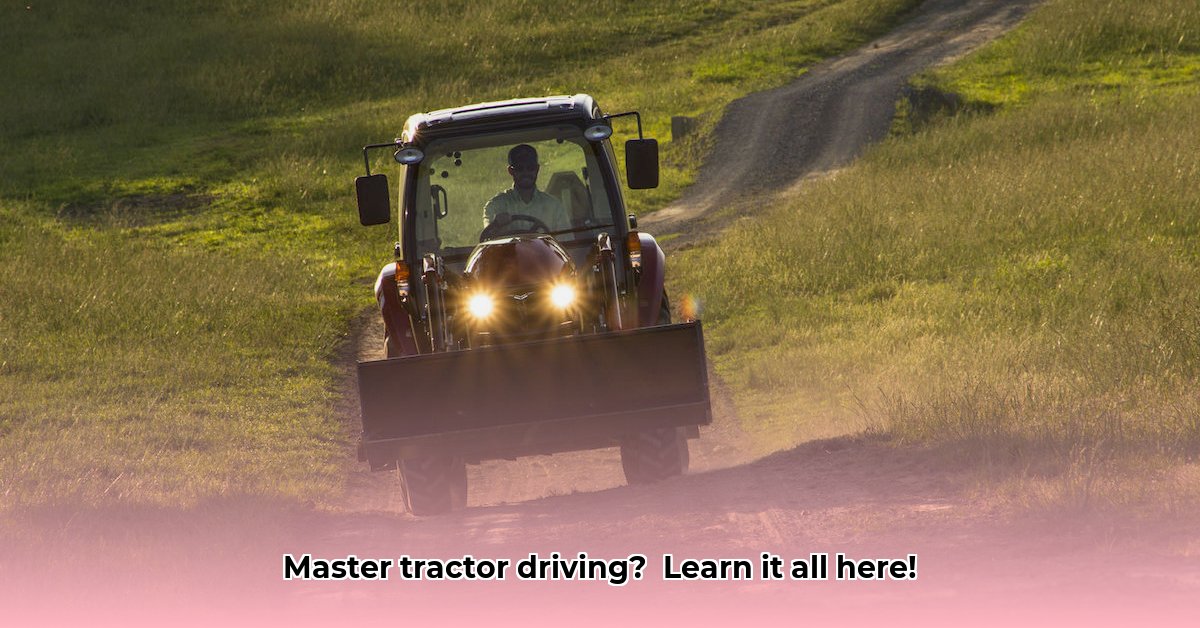
Pre-Operational Checks: Getting Your Tractor Ready
Before starting your tractor, a thorough pre-operational check is crucial for safety and efficiency. This preventative maintenance will save you time, money, and potential injury. Think of it as a pre-flight checklist for your agricultural workhorse.
Fluid Levels: Check engine oil, coolant, transmission fluid, and hydraulic fluid levels. Low levels should be topped off using the correct fluids (refer to your owner's manual). Dirty or gritty fluids indicate a need for a change. Do you routinely check your tractor's fluid levels? Neglecting this can lead to costly repairs.
Tire Condition: Inspect tire pressure (underinflation reduces fuel efficiency and handling) and tread depth (worn treads are a significant safety hazard). Proper inflation is critical for safe and efficient operation. Did you know that under-inflated tires can decrease fuel efficiency by up to 10%? For tire changes, see this helpful guide: Changing Tractor Tires.
Brake Check: Test the brakes. Faulty brakes are extremely dangerous. A quick brake check can prevent a catastrophic accident.
Lights and Signals: Ensure all lights (headlights, taillights, turn signals) are functioning correctly. Proper lighting is vital for visibility, particularly at dawn, dusk, or in poor weather. Approximately 20% of farm accidents are related to poor visibility.
Attachment Inspection: If using attachments (plow, mower, loader), inspect them for damage or loose parts before attaching them to the tractor. Improperly attached implements account for a significant percentage of tractor-related injuries.
Starting and Stopping Your Tractor: The Basics
Starting and stopping a tractor safely requires a methodical approach. These steps, when followed consistently, will protect both you and your equipment.
Engage Parking Brake: Always engage the parking brake before starting the tractor. This prevents accidental movement.
Gear Selection: Shift the gear lever to neutral.
Ignition: Turn the ignition key to start the engine. Listen for any unusual noises – a grinding sound, for instance, may indicate a problem.
Clutch Control: Once the engine runs smoothly, gently release the clutch pedal to avoid jerky movements. A smooth release is vital for protecting the tractor’s drivetrain.
Safe Shutdown: Before turning off the ignition, bring the tractor to a complete stop and engage the parking brake. Allow the engine to idle briefly to cool down components, extending the life of your engine.
Mastering Tractor Controls: Understanding Your Machine
Tractors have numerous controls; understanding their function is critical for safe and efficient operation. Each control plays a vital role in the overall operation of the tractor.
Steering Wheel: Steers the tractor (requires more effort than car steering).
Gear Lever: Selects different speeds (gears). Choosing the correct gear is essential for optimal performance and safety. Incorrect gear selection can lead to stalling or damage.
Throttle: Controls engine RPM (revolutions per minute). Adjust speed according to the task. Slower speeds are necessary for delicate tasks; higher speeds are suitable for open fields.
PTO (Power Take-Off): Transfers power from the engine to attachments (mowers, tillers, etc.). Engage only when needed and always exercise caution.
Hydraulic Controls: Operate the hydraulic system for attachments (loaders, backhoes). Understand how these controls work for each attachment.
Maneuvering Techniques: Confidence on the Farm
Safe and efficient tractor operation involves mastering various maneuvering techniques. Practice is key to developing confidence and skill.
Turns: Execute turns slowly and widely, avoiding sharp turns, especially with heavy loads or attachments.
Slopes: Always drive across slopes, never directly up or down, to reduce the risk of rollover accidents.
Confined Spaces: Practice maneuvering in tight spaces. This skill builds confidence and improves your ability to navigate challenging environments.
Using Attachments: Expanding Your Tractor's Capabilities
Tractor attachments significantly increase versatility. Safe and efficient use is essential.
Hitching and Detaching: Always follow the manufacturer's instructions precisely. Improper attachment/detachment can damage equipment and create hazardous situations.
Attachment Operation: Familiarize yourself with each attachment's operation and safety guidelines before use.
Safety Awareness: Maintain constant awareness of your surroundings, keeping a safe distance from obstacles and others.
Safety Procedures: Your Top Priority
Safety is paramount in tractor operation. It's not a suggestion but a mandatory requirement.
PPE (Personal Protective Equipment): Always wear appropriate PPE: Sturdy clothing, protective eyewear, hearing protection, and steel-toed boots.
Emergency Procedures: Know emergency procedures (engine failure, breakdowns, fire) and how to safely exit the tractor.
Regulations: Understand and comply with all relevant safety regulations (OSHA, state/local guidelines).
Basic Tractor Maintenance: Keeping Your Tractor in Top Shape
Regular maintenance is key to preventing breakdowns and extending your tractor's lifespan.
Regular Oil Changes: Follow the recommended oil change schedule.
Fluid Level Checks: Routinely check all fluid levels and top them off as needed.
Tire Pressure Management: Regularly monitor and adjust tire pressure.
Troubleshooting Common Problems: Solving Issues on the Spot
While preventative maintenance minimizes problems, knowing how to troubleshoot common issues is crucial.
Engine Won't Start: Check the battery, fuel supply, and ignition system. If unsure, seek professional help.
Hydraulic Problems: Check fluid levels and lines for leaks. Leaks require immediate attention.
Conclusion: Your Journey to Tractor Mastery
This guide provides a foundation for safe and effective tractor operation. However, continuous learning and adherence to safe practices are paramount. Remember, your safety and the well-being of others are always the top priority. Happy farming!